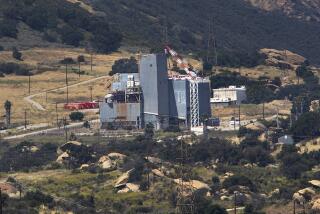Area Remains Contaminated From World War II Experiment : Germ Warfare Test Still Haunts Scottish Isle
- Share via
SECOND COAST, Scotland — An uninhabited island off this hamlet is still lethally contaminated from a British experiment in germ warfare during World War II.
The soil of Gruinard Island bears anthrax toxin deposited during the tests in 1942-43. Anthrax is an infectious disease fatal to humans and animals and is characterized by black pustules. It has been known since ancient times and is believed to be the “plague of boils” that Moses called down on the Egyptians.
Ian MacKenzie, a 66-year-old retired farmer, remembers the day when the island took a lethal dose of the toxin.
“I remember the bomb going off quite distinctly,” he said. “There was quite a bang and plenty of smoke. The wind was favorable, blowing out. But it changed, the smoke came around and caught part of the mainland, and there were rumors that some animals died.”
Land Used for Grazing
Although uninhabited, the island was used, until the tests, for grazing sheep and cattle.
The few people living then along Gruinard Bay on Scotland’s remote northwest coast had not been warned about any danger, though they knew that Britain was doing something secret in the area, MacKenzie said in an interview.
“After the war it came out that they were testing germ warfare,” he added.
A year or two after the war signs were put up around the island and on nearby mainland beaches warning that the island was contaminated and that travel to it was prohibited.
MacKenzie, like others in the area, said he was not greatly concerned at the time: “It never caused me a worry.”
The humpbacked island covers 520 acres and is only 400 yards from the mainland.
Soil Samples Studied
In 1979, the British government, after years of doing little about the contamination except to maintain the warning signs, sent scientists in protective clothing to the island to collect soil samples. The results showed that anthrax spores were still in the soil.
This last May 13, the Ministry of Defense in London announced that decontamination was possible, using a solution of formaldehyde and seawater to treat the soil. A company with experience in soil sterilization was given a $750,000 contract to carry out the work starting this summer.
The infected area is about 2% of the total area of the island, or about 10 acres, said Prof. William Stewart of Scotland’s University of Dundee, a microbiologist who is chairman of a committee set up to advise the Defense Ministry.
‘Mainly One Area’
“It was mainly one area, where the bombs were exploded, but also a small holding area where sheep were tethered,” he said.
In a series of tests, containers with anthrax bacilli in liquid solution were exploded, producing a mist with deadly effect on the tethered sheep.
They began dying within a day, demonstrating that anthrax bombs could be a weapon of germ warfare, Stewart said.
He added that anthrax bacilli was used in the tests because of its killing effect.
“Also, it was very resistant to the heat of a bomb explosion and would survive the detonation. . . . The problem is the persistence of the spores.”
Livestock Vulnerable
Livestock can pick up the disease by grazing on contaminated land. Man and animals can catch it by handling or eating contaminated meat or by breathing the spores.
Why such a long-lived organism was considered for germ warfare is not clear, but Allied governments in World War II were concerned that the Axis powers were developing anthrax toxin as part of their armories, and the Allies had to develop it as well.
Wartime British government papers declassified in 1981 showed that the results of the Gruinard Island tests were passed on to the United States, where production of anthrax bombs was started.
Prime Minister Winston Churchill in 1944 ordered his military chiefs of staff to see whether it would be possible to use anthrax or poison mustard gas on German cities, according to the documents. Among the documents was a feasibility study for an attack on Germany by 2,700 Allied bombers carrying anthrax bombs.
Churchill’s Order
Churchill ordered the studies as a possible way to retaliate if German V-1 and V-2 rockets posed a life-or-death threat to Britain, the documents indicated.
The plans were never put into operation. But Gruinard Island remains as testimony to what germ warfare could do, not only in exterminating populations but also in leaving land uninhabitable for generations.
However, people living near the island show little concern.
“We’ve all just lived with it so long we never think about it,” said a middle-aged woman living four miles from the island.
Mike Stevens, owner of the Ocean View Hotel, which has a view of the island, said he would prefer that the $750,000 to be spent on decontamination be used instead for roads or other public facilities on the mainland.
“The island, even when it is back to a usable state, is less valuable than 520 acres on the mainland,” Stevens said.
The Ministry of Defense says it hopes eventually to return the island to civilian use.
More to Read
Sign up for Essential California
The most important California stories and recommendations in your inbox every morning.
You may occasionally receive promotional content from the Los Angeles Times.













